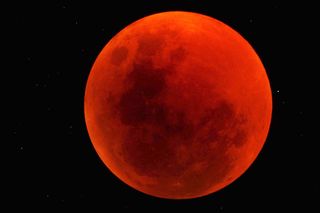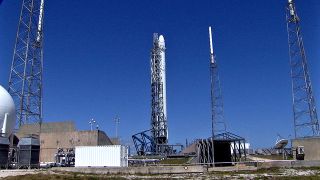
Monday may be a dream come true for space fans, with a rocket launch, Mars and total lunar eclipse aligned in a truly epic cosmic triple play of live webcasts online.
The events of Space Monday (April 14) begin in the late afternoon, when the private spaceflight company SpaceX will launch a robotic Dragon cargo capsule to the International Space Station. Once darkness falls, stargazers with clear skies can see Mars at its brightest (the Red Planet makes its closest approach to Earth since 2008 Monday), followed by a total eclipse of the moon in the overnight hours. Here's how to watch the events live online:

SpaceX plans to launch a Falcon 9 rocket carrying the Dragon spacecraft at 4:58 p.m. EDT (2058 GMT) from a pad at Cape Canaveral Air Force Station in Florida. There will actually be two webcasts of the launch, one by NASA and the other provided by SpaceX. NASA's webcast begins at 3:45 p.m. EDT (1945 GMT), while SpaceX's video feed will begin at 4 p.m. EDT (2000 GMT). You can watch both webcasts of the SpaceX Dragon launch on Space.com.
The late afternoon launch will mark SpaceX's third cargo mission for NASA. The company holds a $1.6 billion deal to make 12 such flights. For this flight, Dragon will carry about 5,000 lbs. (2,268 kilograms) of supplies, scientificexperiments and hardware on this run, including two legs for NASA's humanoid Robonaut 2 droid on the space station.
SpaceX also plans to deploy a set of tiny satellites as secondary payloads on the launch, and test a novel reusable rocket technology using the Falcon 9 booster's first stage, which has been outfitted with four large landing legs with the goal of simulating a re-entry maneuver as it falls back to Earth, then a landing maneuver before splashing down in the Atlantic Ocean.
While SpaceX's rocket launch will dominate the space news during the day, when the sun sets, it's time for Mars and the moon. The Slooh community telescope, NASA and the Virtual Telescope Project will offer live views of the events in four difference webcasts.

You can watch Space.com's night sky webcast page for live views of Mars late Monday, then stick around for no less than three feeds of the total lunar eclipse from observing sites across North America.
Get the Space.com Newsletter
Breaking space news, the latest updates on rocket launches, skywatching events and more!
Mars will take center stage shortly after Dragon blasts into orbit. The Red Planet passes within just 57 million miles (92 million kilometers) of Earth Monday — its closest approach since January 2008. After sunset, Mars will be an orange beacon overhead, blazing as brightly as Sirius, the most luminous star in the sky other than the sun, experts say.
But main event for the night will be the first total lunar eclipse of 2014, which will be visible from all of North and South America, as well as Hawaii and part of Alaska. It is perhaps the most exciting of the night's events (though it technically begins early Tuesday morning Eastern time).
The Slooh, Virtual Telescope Project and NASA webcasts will all run concurrently during the total lunar eclipse. NASA will also offer a live chat with scientists during the eclipse, beginning at 2 a.m. EDT (0600 GMT) Tuesday and running the duration of the moon event. You can follow NASA's webcat live here.
The lunar eclipse will begin at 12:53 a.m. EDT (0453 GMT) Tuesday (April 15), when the moon plunges into Earth's outer shadow. The "totality" phase, in which the moon is completely veiled by Earth's shadow, starts at 3:06 a.m. EDT and lasts for more than an hour, ending at 4:24 a.m. EDT.
The moon should be quite a dramatic sight during the totality phase, experts say.
"Sunlight bent by our atmosphere around the curvature of the Earth should produce a coppery glow on the moon," Space.com skywatching columnist Joe Rao wrote in an April 8 guide. "At this time, the moon, if viewed with binoculars or a small telescope, will present the illusion of seemingly glowing from within by its own light."

The moon will emerge completely from Earth's outer shadow at 6:37 a.m. EDT (1037 GMT), bringing an official end to the eclipse.
The upcoming shadow dance is the first total lunar eclipse since December 2011, but the world won't have to wait so long for the next one. Tuesday's event is the first of a "tetrad" of four total lunar eclipses occurring at roughly six-month intervals. The next one will occur on Oct. 8 of this year, and the other two on April 4 and Sept. 28 of 2015.
Editor's Note: If you snap an amazing picture of SpaceX's launch, Mars, the total lunar eclipse or any other night sky view that you'd like to share for a possible story or image gallery, send photos, comments, and your name and location to managing editor Tariq Malik at spacephotos@space.com.
Follow Mike Wall on Twitter @michaeldwall and Google+. Follow us @Spacedotcom, Facebook or Google+. Originally published on Space.com.
Join our Space Forums to keep talking space on the latest missions, night sky and more! And if you have a news tip, correction or comment, let us know at: community@space.com.

Michael Wall is a Senior Space Writer with Space.com and joined the team in 2010. He primarily covers exoplanets, spaceflight and military space, but has been known to dabble in the space art beat. His book about the search for alien life, "Out There," was published on Nov. 13, 2018. Before becoming a science writer, Michael worked as a herpetologist and wildlife biologist. He has a Ph.D. in evolutionary biology from the University of Sydney, Australia, a bachelor's degree from the University of Arizona, and a graduate certificate in science writing from the University of California, Santa Cruz. To find out what his latest project is, you can follow Michael on Twitter.
